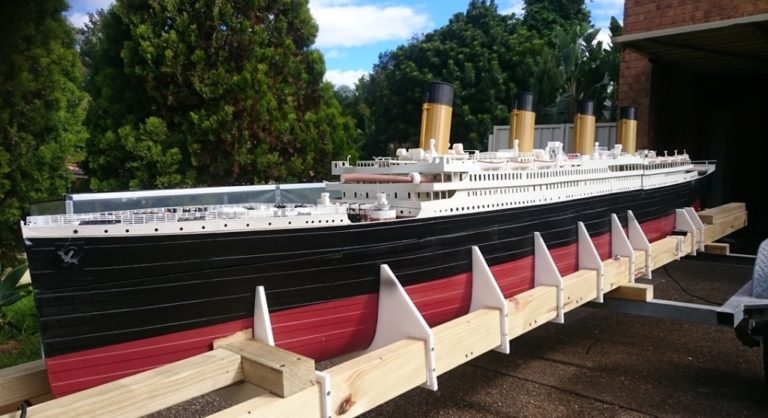Saving a 3D Printed Titanic Model from the Original’s Fate
The Titanic features large in the mind of the public. This is partly due to the blockbuster film of the same name featuring a young, handsome Leonardo DiCaprio and schmaltzy music by Celine Dion designed to wring tears from your eyes. But even without this movie, the RMS Titanic is a boat worth remembering. It was considered unsinkable, an epithet of herculean hubris, and was the largest ship on the water at the time of its completion. Setting a new standard for opulence and luxury in the first class areas of cruise liners, the ship was outfitted with a swimming pool, upscale restaurants, and ostentatiously adorned cabins. Unfortunately, what it was not equipped with were enough lifeboats for its passengers, a fact that became abundantly clear when the unsinkable boat did exactly what it is remembered best for and sank, taking the lives of more than 1,500 of the people aboard.
The reason for its accident has been the center of a great deal of speculation and there has been some confusion over why, exactly, the ship ran into the iceberg in the first place. Bernie Dohnt has a theory about why the accident occurred and he didn’t get that key insight from academic expertise in the vessel, but instead as the result of a near accident that occurred with his own 1/72 scale 3D printed reproduction of the gargantuan ocean liner. That’s right. Dohnt modeled, printed, and assembled a 1/72 Titanic for himself and then planned to sink it.
This isn’t a project for beginners. Dohnt, a native of Australia, began by serving in the Navy for seven years and then continuing to work for a variety of Navy contracting companies, and as a result he really knows boats. Dohnt found that he had a strong desire to build model boats, but instead of using wood and fiberglass, he wanted something that took care of the crafting aspects for him. He also didn’t want a diminutive model, but had plans to create on a vast scale. After realizing that 3D printing would perfectly fit the bill, he set about combining DIY 3D printer kits to create one that could handle the size pieces he needed to produce. His first boat project was the creation of a 1.6 meter long Armidale-class patrol boat. This boat simply whet his thirst, as he explained in an interview with Failuremag:
“[M]y end goal was to do a 1/72-scale Titanic model and in September 2015, I started printing it off. It was a very slow process but within nine months I started to see the shape of Titanic slowly come together…It’s modeled off of line drawings for a standard, DIY model kit. From those line drawings I was able to sketch out every bulkhead and partition in the line drawings and it was just a matter of joining the dots to make the hull. The end result is that the model of the hull is insanely accurate.”
The final model, ballast and all, weighs in at approximately 440 pounds (200 kilos) and contains over 150 pounds (70 kilos) of plastic. Dohnt has since released the design for sale, and it contains files for well over 3,000 different printed parts, something which could eventually lead to the existence of multiple Titanic models at this scale.

This herculean task is one that gave Dohnt an expert’s working knowledge of 3D printers and 3D printing, beginning with the construction of the printer itself. After getting solid advice from the president of Maker Farm, Colin Farrer, Dohnt assembled a 3D printer comparable to a $12,000 (AUD) machine available through MakerBot but for about $11,000 (AUD) less. Dohnt highly recommends taking a path like this because despite the initial frustrations and slow downs that it can cause, it is the equivalent of a master’s class, leaving you with the knowledge to address any problems that arise during the project. After all of this investment of time, effort, and money, Dohnt wasn’t going to just own the model. Instead, he planned to stage an accurate recreation of the moment that truly secured its place in history: its sinking. And as part of a routine test run, he discovered what he thinks is the key to understanding the ship’s sinking: “What I found is that the rudder only works under power. If the rudder is hard over and there’s no power on the propellers but the boat is still moving through the water, it doesn’t turn at all. Essentially what happened is that when the real Titanic saw the iceberg, they put the rudder hard over while they were full steam ahead. They started to turn but then standard procedure was to put the propellers to full stop. If the real Titanic reacted in the same way as the highly accurate model I built, that explains why they hit the iceberg. Even though the rudder was hard over, it only works under power, so they started coasting straight ahead.” Straight into disaster and the continued fascination of the public’s imagination.

But this Titanic was to have a very different fate that its sunken inspiration. After deciding that he was going to sink the model, he turned to Kickstarter in order to help recoup some of the expense of having create the model. The news of his model reached the ears of the Titanic the Exhibition in Sydney and, as he was not able to meet his Kickstarter goal, Dohnt decided to sell the model, at a significant loss, to the exhibit for display. What has he learned from this experience? That he would like to build a bigger model of course! He currently has plans to create a 1/24-scale model which would actually include enough room inside for him to sail with it.
Source: 3dprint.com










